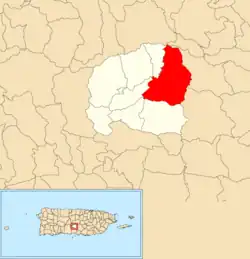Caonillas Arriba | |
|---|---|
Barrio | |
 Location of Caonillas Arriba within the municipality of Villalba shown in red | |
 Caonillas Arriba Location of Puerto Rico | |
| Coordinates: 18°08′32″N 66°26′06″W / 18.142198°N 66.434968°W[1] | |
| Commonwealth | |
| Municipality | |
| Area | |
| • Total | 8.11 sq mi (21.0 km2) |
| • Land | 8.08 sq mi (20.9 km2) |
| • Water | 0.03 sq mi (0.08 km2) |
| Elevation | 1,424 ft (434 m) |
| Population (2010) | |
| • Total | 1,537 |
| • Density | 190.2/sq mi (73.4/km2) |
| Source: 2010 Census | |
| Time zone | UTC−4 (AST) |
Caonillas Arriba is a barrio in the municipality of Villalba, Puerto Rico. Its population in 2010 was 1537.[3][4][5]
History
Caonillas Arriba was in Spain's gazetteers[6] until Puerto Rico was ceded by Spain in the aftermath of the Spanish–American War under the terms of the Treaty of Paris of 1898 and became an unincorporated territory of the United States. In 1899, the United States Department of War conducted a census of Puerto Rico finding that the population of Caonillas Arriba barrio was 2,200.[7]
| Census | Pop. | Note | %± |
|---|---|---|---|
| 1900 | 2,200 | — | |
| 1910 | 1,627 | −26.0% | |
| 1920 | 1,883 | 15.7% | |
| 1930 | 1,588 | −15.7% | |
| 1940 | 1,605 | 1.1% | |
| 1950 | 1,718 | 7.0% | |
| 1960 | 1,591 | −7.4% | |
| 1970 | 1,778 | 11.8% | |
| 1980 | 1,473 | −17.2% | |
| 1990 | 1,333 | −9.5% | |
| 2000 | 1,811 | 35.9% | |
| 2010 | 1,537 | −15.1% | |
| U.S. Decennial Census 1899 (shown as 1900)[8] 1910-1930[9] 1930-1950[10] 1980-2000[11] 2010[12] | |||
Sectors
Barrios (which are, in contemporary times, roughly comparable to minor civil divisions)[13] in turn are further subdivided into smaller local populated place areas/units called sectores (sectors in English). The types of sectores may vary, from normally sector to urbanización to reparto to barriada to residencial, among others.[14][15][16]
The following sectors are in Caonillas Arriba barrio:[17]
Carretera 151 Intersección 553, La Gallera (Sector San Miguel), Sector Caonillas which includes La Sierrita, La Escuela, Los Aponte, Cubones Norte, El Puente, Caonillas (Ceo Rivera), Finca El Coroco, La Terraza, and El Empalme, Sector Dajaos (La Toyosa, Los Cruz, Carretera 151 Intersección 559), Sector El Limón, (El Palmar, La Hacienda, La Cuesta Limón, Los Santiago, La Escuela, El Hoyito, Los Vázquez, Los Rivera, El Camino Valillo Carretera 151), and Sector La Ortiga (El Pueblito).
As of 2015, La Sierrita has not had regular water service for years.[18] The Federal Emergency Management Agency earmarked money in 2020 to be used for permanent upgrades to water service systems for residents of La Sierrita, among others.[19]
See also
References
- 1 2 "US Gazetteer 2019". US Census. US Government.
- ↑ U.S. Geological Survey Geographic Names Information System: Caonillas Arriba barrio
- ↑ Picó, Rafael; Buitrago de Santiago, Zayda; Berrios, Hector H. Nueva geografía de Puerto Rico: física, económica, y social, por Rafael Picó. Con la colaboración de Zayda Buitrago de Santiago y Héctor H. Berrios. San Juan Editorial Universitaria, Universidad de Puerto Rico,1969.
- ↑ Gwillim Law (20 May 2015). Administrative Subdivisions of Countries: A Comprehensive World Reference, 1900 through 1998. McFarland. p. 300. ISBN 978-1-4766-0447-3. Retrieved 25 December 2018.
- ↑ Puerto Rico: 2010 Population and Housing Unit Counts.pdf (PDF). U.S. Dept. of Commerce, Economics and Statistics Administration, U.S. Census Bureau. 2010.
- ↑ "Anuario del comercio, de la industria, de la magistratura y de la administración. 1881". Biblioteca Nacional de España (in Spanish). p. 1614. Retrieved 4 April 2023.
- ↑ Joseph Prentiss Sanger; Henry Gannett; Walter Francis Willcox (1900). Informe sobre el censo de Puerto Rico, 1899, United States. War Dept. Porto Rico Census Office (in Spanish). Imprenta del gobierno. p. 165.
- ↑ "Report of the Census of Porto Rico 1899". War Department Office Director Census of Porto Rico. Archived from the original on July 16, 2017. Retrieved September 21, 2017.
- ↑ "Table 3-Population of Municipalities: 1930 1920 and 1910" (PDF). United States Census Bureau. Archived (PDF) from the original on August 17, 2017. Retrieved September 21, 2017.
- ↑ "Table 4-Area and Population of Municipalities Urban and Rural: 1930 to 1950" (PDF). United States Census Bureau. Archived (PDF) from the original on August 30, 2015. Retrieved September 21, 2014.
- ↑ "Table 2 Population and Housing Units: 1960 to 2000" (PDF). United States Census Bureau. Archived (PDF) from the original on July 24, 2017. Retrieved September 21, 2017.
- ↑ Puerto Rico: 2010 Population and Housing Unit Counts.pdf (PDF). U.S. Dept. of Commerce Economics and Statistics Administration U.S. Census Bureau. 2010. Archived (PDF) from the original on 2017-02-20. Retrieved 2019-08-02.
- ↑ "US Census Barrio-Pueblo definition". factfinder.com. US Census. Archived from the original on 13 May 2017. Retrieved 5 January 2019.
- ↑ "Agencia: Oficina del Coordinador General para el Financiamiento Socioeconómico y la Autogestión (Proposed 2016 Budget)". Puerto Rico Budgets (in Spanish). Retrieved 28 June 2019.
- ↑ Rivera Quintero, Marcia (2014), El vuelo de la esperanza: Proyecto de las Comunidades Especiales Puerto Rico, 1997-2004 (first ed.), San Juan, Puerto Rico Fundación Sila M. Calderón, ISBN 978-0-9820806-1-0
- ↑ "Leyes del 2001". Lex Juris Puerto Rico (in Spanish). Retrieved 24 June 2020.
- ↑ "PRECINTO ELECTORAL VILLALBA 065" (PDF). Comisión Estatal de Elecciones (in Spanish). PR Government. 21 September 2019. Retrieved 23 July 2020.
- ↑ Texidor Guadalupe, Darisabel (2015-05-06). "En Caonillas Arriba llevan años sin agua". Primera Hora (in Spanish). Retrieved 2021-04-07.
- ↑ "FEMA obligates $365M to rebuild Puerto Rico's water systems". News is My Business. 2020-04-24. Retrieved 2021-04-07.